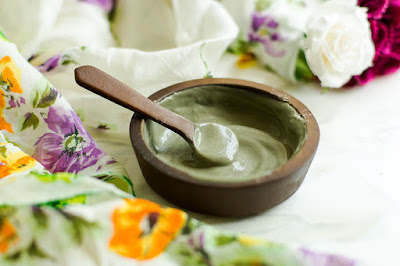Hello readers!
Did you know that, clay has been used in beauty recipes for centuries?
And it’s
no secret that Cleopatra loved them, so did Queen Nefertiti.
It can work
wonders on skin and is a great one of the best pick-me-ups for the skin.
Especially, clay masks work best on oily or acne-prone skin because they soak
up all traces of dirt and grease.
Having amazing medicinal and cosmetic properties, clay is
now becoming more and more popular as a rediscovered treatment for numerous
skin conditions.
Good cosmetic clays condition and
nourish your skin by removing the dead cells and extracting the extra oils and
impurities from the surface of the skin.
And there’s a diy clay mask for every skin type — from one
for anti-ageing, to dealing with dryness, treating pimples and controlling
acne, cleansing and firming up the skin.
Types Of Clay
Due to the different compositions of their mineral contents,
clays come in array of colors, texture and having different properties.
Bentonite clay is the most beneficial of all clays. It has
potent absorbing abilities, so can be used to pull out toxins, chemicals,
impurities and even heavy metals from the skin. It’s a rich source of
skin-friendly minerals like magnesium, silica, and calcium. It also helps to
supply oxygen to cells and has an alkalizing effect. You can mix it with
healing and antibacterial ingredients to make a mask which can safely and
effectively be used for keeping healthy skin.
Others, like French Green clay and Rhassoul clay have
properties to absorb excess sebum and therefore are suitable for oily skin.
They have magnesium oxide that cleanses the skin and sucks out grease from it.
Red clay is rich in iron oxides that revamp skin cells and
brighten the skin.
Here, in my hometown Volos, at Melani- beach in Pelion mountain, we can find natural green clay and turn a day to the sea into a natural SPA!
So, here we are, me and my best friend Kiki, having a natural clay mask and a lot of fun while waiting for the mask to dry!
At this foto you can see us before.....
Where To Apply And How Often
Don’t smear the clay mask everywhere on your face, confine
it to the regions of your cheeks, forehead, nose, and chin avoiding your eyes
and lips.
People having oily skin
can use clay masks for 2-3 times a week or so. One can wash the mask with plain
water.
And yes my dear male readers, clay masks can be used by men!
Men too are in search of means to rein in excess skin oil
and unblock the pores. The two key properties of a clay mask are deep cleansing
and detoxifying and therefore clay masks are helpful to both women as well as
men. Men can use a clay mask one time a week, after shaving
and before toning their skin.
How To Make And Use A Clay Mask
You will need:
- Bentonite clay: 1 tablespoon
- Clean water: 1-2 tablespoons (preferably distilled or boiled and cooled water)
- Oat: 1 tablespoon, ground
- Tea tree essential oil: 4 drops
Method: Mix the bentonite clay and oats in a small glass
bowl. (Never use a metal utensil or bowl when working with bentonite
clay.) Mix in enough water to make a
spreadable paste. Add in 4 drops of tea tree oil and stir with a wooden or
plastic spoon thoroughly. Apply to the face (avoiding eyes and lips area) for
10-15 minutes. Rinse off the mask with lukewarm water and a washcloth.
Tip: To grind oats, place the necessary quantity of oats in
a spice grinder, blender, or food processor. Pulse oats until coarse and
flour-like.
2. Acne-Fighting Honey And Clay Mask: Honey has
antibacterial and antioxidant properties; therefore it is ideal for getting
natural glow while combating acne and nourishing aging skin as well.
You will need:
- Bentonite clay: 1 tablespoon
- Clean water: 1 table spoon (preferably distilled or boiled and cooled water)
- Organic honey: 1 tablespoon
Method: Mix the bentonite clay, honey, and water. (Don’t use
a metal utensil or bowl when working with bentonite clay.) Apply to the face
for 10-15 minutes. Rinse off the mask
with lukewarm water and a washcloth.
3. Soothing Yogurt And Clay Mask: Yogurt acts as an
exfoliator and can tighten skin pores as it contains natural lactic acid.
Yogurt also has anti-bacterial and anti-fungal properties that help to keep
blemishes at bay.
You will need:
- Bentonite clay: 1 tablespoon
- Plain yogurt: 1 tablespoon (unflavored and unsweetened)
Method: Mix well the bentonite clay and yogurt. (Don’t use a
metal utensil or bowl when working with bentonite clay.) Apply to the face for
10-15 minutes. Rinse off the mask with
lukewarm water and a washcloth.
Natural Beauty Tip: Don’t let clay mask dry fully. There are
three phases of a clay mask.
First is the damp phase where your skin sucks in
the beneficial minerals from the outside.
Second is beginning of the dry phase,
which exercises your capillaries and promotes blood flow as the mask cools and
contracts.
Third is the dry phase, which sucks out moisture from the surface of
your skin, leading to dehydration and irritation.
Not only does skin then feel
dry, tight, and sometimes itchy, but when you offset it by slathering on extra
face cream, you’re just smothering your freshly cleansed skin.
So when you use
a clay mask, don’t allow it to reach the flaky stage before you begin rinsing.
When you begin to see it drying (which usually means it turns lighter in color)
but it still feels a bit sticky, it’s time to rinse that sucker off—so it
doesn’t suck the life out of your skin.
Quote of this post: Beauty is for Everyone!




